African heart-nosed bats can hear the footsteps of a beetle walking on sand from a distance of more than six feet. – [Amazing Bat Trivia]
That’s really got nothing to do with echolocation (the sonar system used by bats) or the device I’m about to describe, but it’s a pretty stunning piece of trivia.
Bat’s are fascinating creatures and here in Melbourne they are a common sight. At dusk streams of grey-headed flying foxes leave their camp in the Royal Botanical Gardens to plunder fruit and nectar from suburban flowering gums. The number of urban bats have swelled in recent years, giving the impression that the grey-headed flying fox is thriving, but in reality Australia’s bat population has decreased by 30% over the past decade. The increase in urban bat colonies is the result of ongoing destruction to the bats native feeding grounds. The Melbourne Royal Botanical Gardens is now the only breeding colony of grey-headed flying foxes in the state of Victoria. In 2001 the Royal Botanical Gardens started shooting these animals in an insane attempt to curb the local bat population. Thanks to public outcry and a dedicated group of protesters this practice was stopped. The grey-headed flying fox has since been classified as a vulnerable species by the Australian government.
I was once passed by a grey-headed flying fox while travelling down a deserted Punt Road at 2 am. The bat had a wingspan of about a metre, it was a mesmerising and beautiful experience. Yes, I’m quite a fan of this fellow mammal, however I’m not so obsessed that I go out at night with the specific intent of tracking them down; or at least I wasn’t until I discovered there was such a thing as a bat detector.
A bat detector is an instrument that will detect the presence of bats by tuning into the echolocation ultrasounds they produce. There are a variety of commercial bat detectors available but what excited me were the numerous internet sites with home-built detector circuits. I stumbled across these sites while trying to decide what to do with a 1968 Braun Cylindric T2 cigarette lighter. What resulted was the Cylindric Ultrasonic Bat Detector.
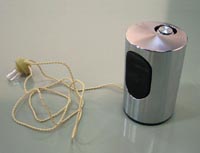
My friend Gareth found the Braun Cylindric T2 cigarette lighter in a Canberra op-shop; it’s a stunning object. Designed by Dieter Rams in 1968 it was (according to this site) one of Rams’ favourite products. It is quite heavy, this particular version is chrome plated steel, but it balances nicely in the hand and the large black ignition button is a pleasure to use (in fact it’s oddly addictive, if I have the thing in my hand I often find myself obsessively pressing the button and I have to put the lighter down in order to stop).
Gareth gave me the lighter with the suggestion that I may want to turn it into something. I thought it would make a great something so I started searching for what that something might be. And then I found this site, and this site, and this one, and this one, and this one, (and the list goes on...) all of them dedicated to the construction of bat detectors. This is the sort of obsessive social behaviour I love, I just had to join in.
After looking at more than 15 different circuit diagrams I decided to tackle the Enhanced Simple Bat Detector design by Tony Messina. This design is based on two audio amplifier IC’s and a 7 stage binary counter. It’s a variation on Tony’s Simple Bat Detector with a few extra components to control amplifier gain and electrical stability.

The circuit operates as a frequency divider. Ultrasonic signals are collected by the transducer and amplified by the two LM386 audio amplifier chips. The signal is then fed to the CD4024 binary counter which divides the frequency by 16. Output from the frequency divider is passed through a variable resistor (for volume control) and on to a high impedance ceramic earphone. This circuit treats the ultrasonic waves as a series of binary pulses; it’s basically a 2 bit analogue to digital convertor, the wave is either on or off. The CD4024 counts (in binary) 16 pulses and then outputs a single pulse. The resulting sound is kind of like a Geiger counter, i.e. a series of clicks. As the amount of ultrasonic noise increases so do the number of clicks. The binary nature of the circuit means that the amplitude of the ultrasonic sound is not translated (the sound is either loud enough to trigger the counter or it’s not), hence the volume control is useful for adjusting the clicking noises to a comfortable level but it does not make a quiet bat louder (to achieve amplitude translation a different and far more complicated circuit like this one would be required).
Tony Messina has a useful list of parts suppliers here (he even lists Australian suppliers) but I had trouble finding a local source for the ultrasonic transducer he recommended. I decided to substitute it for a T/R40-16B (purchased from Jaycar for AU$4.95; part number AU5550).
This ultrasonic transducer can operate as both a transmitter and a receiver; I didn’t use the transmitter function. The specifications for the transducer give a centre frequency of 40kHz, this is a standard frequency for most ultrasonic devices and luckily it’s also a common bat frequency. Tony suggests de-tuning the transducer with a 6.8mH RF choke. When wired in parallel across the transducer the choke flattens the transducers frequency response. The transducer will be less sensitive at 40kHz but will have a larger frequency range (possibly as great as 20 to 50kHz) and will respond to a wider variety of bats. Unfortunately introducing an RF choke caused my circuit to oscillate so I left it off (it may be a problem with the type of transducer I’m using). I also omitted the stability components (the 10 ohm resistor and 50nF capacitor) from the amplifier IC’s because of problems with oscillation; and I removed the 220uF power capacitor because I ran out of space inside the lighter (With the 220uF cap. removed you could also omit the 220 ohm resistor, mine was already soldered in so I didn’t bother. The missing components are shown greyed-out in the circuit diagram above).
Disassembling the lighter took a couple of minutes; there were just two screws holding it together, it’s a very impressive design. With the fuel tank removed the lighter was a hollow shell; I needed some kind of internal structure to mount the circuit and switch assembly. I turned to my boxes of miscellaneous crap and I found this.
Actually I found 12 of them. I wouldn’t call myself a hoarder but I guess I have to ask myself just how many spent ink cartridges do I need. Right now I just need one.
The ink cartridge wedged firmly into the lighter’s shell and by inserting a metal tag into the cartridge’s outlet I was able to screw it in place. With the cartridge installed there is just enough space to slide a 9V battery down beside it. Opposite the battery I mounted an extra large micro switch. The micro switch is positioned under the lighter’s large black button and gives a nice audible ‘click’ when pressed.
I also installed a second switch in the circuit; a mini slide switch. Both switches can be seen in the above image. The micro switch is a momentary type and is designed for hand held operation of the detector. The slide switch is an on-off switch that provides for hands free operation (i.e. when the detector is sitting on a table).
When I started the mod I decided that I didn’t want to damage any of the existing components (in case I ever wanted to return the lighter to its former glory). This placed some interesting constraints on the mod. I wanted the bat detector to have; an exposed ultrasonic transducer, a headphone socket, a volume control, an on-off switch and a power indicator LED. Locating this functionality within Rams’ minimal interface design was at times quite a challenge.
And at other times not. The installation of the ultrasonic transducer was totally straight forward, the existing flame outlet on the lighter seemed made to order (the transducer can be seen here set in black foam to isolate it from handling noise). Apart form the large momentary button on the side all other controls were located in the base of the lighter.
There was a small hole here for refilling the lighter. It was too small for a standard 3.5mm audio plug but could accommodate a 2.5mm plug (with a few modifications to the plug). The problem with locating the headphone socket here was that I wanted the detector to work while sitting upright, in this position the base of the lighter has a clearance of only 2mm from the table surface. I needed a right angle 2.5mm headphone connector with a depth of just 2mm, not the sort of thing Tandy have lying around.
So I attacked a standard 2.5mm plug with a file,
and ended up with this.
I had to do similar mods to the slide switch and LED, cutting and filing them to fit the air vents in the base of the lighter.
For the volume knob I reused the lighters flame control dial. With the help of some heat shrink tubing I attached a squashed aluminium rod to the dial.
The rod passed through the circuit board and into the centre hole of the volume trim pot.
Here you can see the battery, ink cartridge and switch assembly being fitted.
With everything installed there was very little space left over.
The completed bat detector is almost identical to the original Braun lighter. The only visible difference is the ultrasonic transducer on the top,
and the controls I’ve added to the base. It even weighs about the same.
And it actually works (I’m always surprised when that happens). If you don’t have a bat on hand you can test a bat detector by pointing it at fast-running water; just turn your kitchen tap on full and start the detector. The faster the water, the more ultrasonic sound produced.
The bat detector has just spent 3 weeks at VCA gallery in an exhibition called slave curated by Christopher LG Hill, Kain Picken, Rob McKenzie and Nick Selenitsch. (No bats were found).
Update 17th September 2009:
Steven has been experimenting with the circuit (see the comments) and reports to have increased sensitivity by adding a 0.1uF capacitor from the amplifier stage (Steven has connected to pin 1 on the binary counter) to the potentiometer. He reports:
here is the picture of the cylindric bat detector i made from the cylindric bat detector site i spread the parts out a little so theres less likely to be any interfearence . ive shortened the wires from the board to the jaycar electronics transducer so that eliminates the need to bround myself to the positive like i did and ive added a 0.1uf mkt cap from pin 1 of the binary counter to one of the pins i have the pot wires solderd to works excellant have yet to do some outdoor testing away from the suburb and out in the bush
Nice work Steven, thanks for the update.
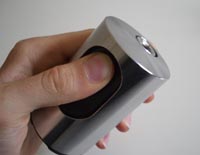
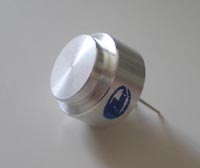
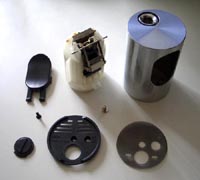
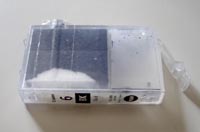
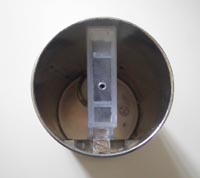
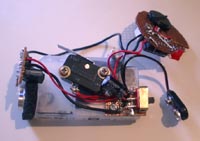
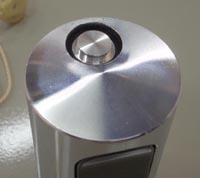
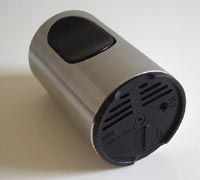
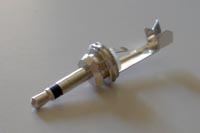
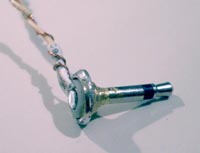
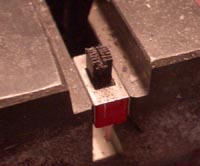
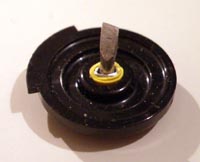
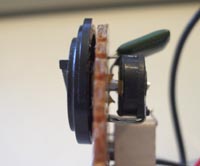
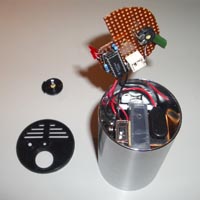
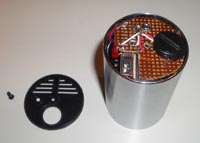
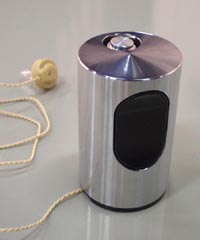
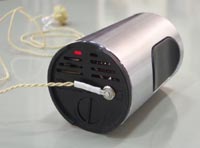

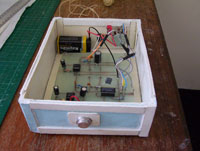
52 Comments